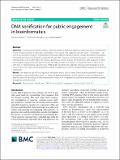Files in this item
DNA sonification for public engagement in bioinformatics
Item metadata
| dc.contributor.author | Plaisier, Heleen | |
| dc.contributor.author | Meagher, Thomas Robert | |
| dc.contributor.author | Barker, Daniel | |
| dc.date.accessioned | 2021-07-18T20:30:14Z | |
| dc.date.available | 2021-07-18T20:30:14Z | |
| dc.date.issued | 2021-07-15 | |
| dc.identifier | 274948066 | |
| dc.identifier | e32fb59a-37e3-4510-9dc4-99d4c23046f1 | |
| dc.identifier | 000674894000002 | |
| dc.identifier | 85110161192 | |
| dc.identifier.citation | Plaisier , H , Meagher , T R & Barker , D 2021 , ' DNA sonification for public engagement in bioinformatics ' , BMC Research Notes , vol. 14 , 273 . https://doi.org/10.1186/s13104-021-05685-7 | en |
| dc.identifier.issn | 1756-0500 | |
| dc.identifier.uri | https://hdl.handle.net/10023/23603 | |
| dc.description | Funding: This work was funded by the Science and Technology Facilities Council (STFC) grant numbers ST/R000328/1 and ST/T000872/1. | en |
| dc.description.abstract | Objective: Visualisation methods, primarily color-coded representation of sequence data, have been a predominant means of representation of DNA data. Algorithmic conversion of DNA sequence data to sound – sonification – represents an alternative means of representation that uses a different range of human sensory perception. We propose that sonification has value for public engagement with DNA sequence information because it has potential to be entertaining as well as informative. We conduct preliminary work to explore the potential of DNA sequence sonification in public engagement with bioinformatics. We apply a simple sonification technique for DNA, in which each DNA base is represented by a specific note. Additionally, a beat may be added to indicate codon boundaries or for musical effect. We report a brief analysis from public engagement events we conducted that featured this method of sonification. Results: We report on use of DNA sequence sonification at two public events. Sonification has potential in public engagement with bioinformatics, both as a means of data representation and as a means to attract audience to a drop-in stand. We also discuss further directions for research on integration of sonification into bioinformatics public engagement and education. | |
| dc.format.extent | 4 | |
| dc.format.extent | 558282 | |
| dc.language.iso | eng | |
| dc.relation.ispartof | BMC Research Notes | en |
| dc.subject | Bioinformatics | en |
| dc.subject | Sonification | en |
| dc.subject | DNA | en |
| dc.subject | Sequence | en |
| dc.subject | Public engagement | en |
| dc.subject | Raspberry Pi | en |
| dc.subject | Sonic Pi | en |
| dc.subject | LB Theory and practice of education | en |
| dc.subject | QA75 Electronic computers. Computer science | en |
| dc.subject | QH301 Biology | en |
| dc.subject | QH426 Genetics | en |
| dc.subject | DAS | en |
| dc.subject.lcc | LB | en |
| dc.subject.lcc | QA75 | en |
| dc.subject.lcc | QH301 | en |
| dc.subject.lcc | QH426 | en |
| dc.title | DNA sonification for public engagement in bioinformatics | en |
| dc.type | Journal article | en |
| dc.contributor.sponsor | Science & Technology Facilities Council | en |
| dc.contributor.institution | University of St Andrews. School of Biology | en |
| dc.contributor.institution | University of St Andrews. Centre for Biological Diversity | en |
| dc.contributor.institution | University of St Andrews. Scottish Oceans Institute | en |
| dc.contributor.institution | University of St Andrews. St Andrews Sustainability Institute | en |
| dc.contributor.institution | University of St Andrews. Centre for Research into Ecological & Environmental Modelling | en |
| dc.identifier.doi | 10.1186/s13104-021-05685-7 | |
| dc.description.status | Peer reviewed | en |
| dc.identifier.url | https://www.researchsquare.com/article/rs-471137/v1 | en |
| dc.identifier.grantnumber | ST/T000872/1 | en |
This item appears in the following Collection(s)
Items in the St Andrews Research Repository are protected by copyright, with all rights reserved, unless otherwise indicated.

